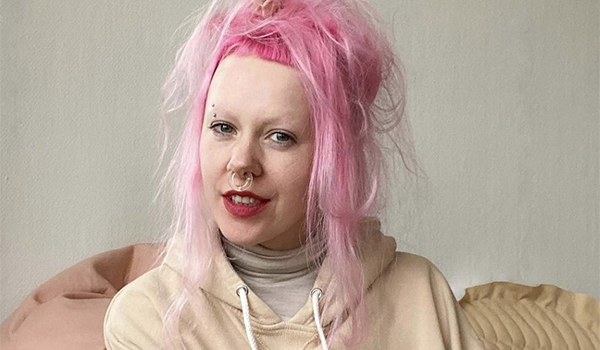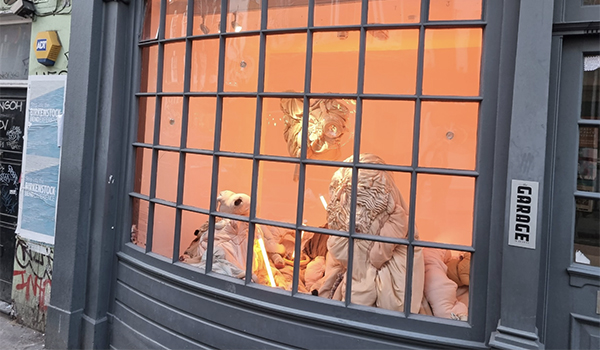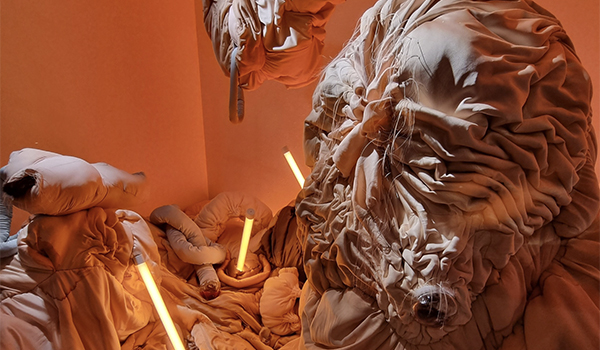The exhibition “Pure Filth” by Norwegian artist Annike Flo is currently on show at The Smallest Gallery in Soho.
Working critically with scenography, textiles and bio art, Annike Flo’s artistic practice centres on staging encounters with organisms and other entities, with a focus on relinquishing space and decentering the human.
Through a post-humanist lens, “Pure Filth” seeks to explore and materialise the queerness and erotic possibilities of the human condition as a meta-organism. The display portrays a site of coalescence, disintegration, and reproduction where intimately entwined materials are given agency, and the line between the artist and her surroundings begins to blur and dissolve.
Here we chat with Annike, getting to know more about her evocative and tactile artistic practice, the themes explored in the show, and the ways in which the exhibition disrupts conventional binaries and systems.
Aleksandra Wojt: Your artistic practice is placed at the intersection of scenography, textiles and bio art. Would you be able to provide more insight into the unique components that your latest installation, “Pure Filth”, incorporates?
Annike Flo: “Pure Filth” is a fleshy landscape with various elements slithering in and out of each other. It is made from secondhand silk, leather and fur, blood, hair; microorganisms from myself, silkworm, ferret, cow and the opening night audience, which all grow together on agar in the handblown glass containers by artist Julie Shirani Kausland. I’m fascinated with how microbiology has revealed us as meta-organisms, consisting of a myriad of different cells and organisms working together in intricate systems. If we are no longer individuals, it feels exciting and necessary to reconsider a lot of the categories, binaries and systems we think with. We are heaving sites of consummation, decay and reproduction of our own cells and other beings. What can the erotic be in a world seen through a post-humanist lens?

Aleksandra: I regard “Pure Filth” as a natural progression of your previous work, with the theme of sexuality and queerness taking on a more prominent role. Can you share how you came to this point in your artistic practice?
Annike: For the last 5 years, I’ve been working with other organisms as a part of my creative practice. Sensual oyster mushrooms with their skin-like texture spread clouds of spores; containers overflood with leaky, furry, colonies of microorganisms. The erotic has always been a part of these works because these creatures do their life regardless of where they are, but I have not had the chance to explicitly dive into it before this project. Another erotic and queer aspect is the materials. Having worked in costume for years, as well as being a part of kink & club communities, textiles, leather, and fur are very close to me. Sexuality and the queer have been, and still often are, expressed through silk, fur, feather, hair, and leather – all of which are made from other creatures. They are similar to our own skin, hair and fluids, but we also respond to them as sexy in their own right and because of what they represent to us. The project has been all about creating with these aspects and influences in my life, as well as getting mixed up with these other organisms. Being mixed up is erotic.
Aleksandra: How did the context of exhibiting at The Smallest Gallery in Soho inform your work?
Annike: Having early conversations with Phil Levine and Andreia Costa from the gallery, I developed Pure Filth with both the window setting and Soho in mind. Soho is so thick with queer histories, with sex, with partying. It is a place heaving with life every day and every night. It was a joy to let all of that into the work. It definitely invites you to be brave and do your thing.
Aleksandra: In your artistic practice, you’re interested in creating spaces of encounter. Considering the posthumanist framework through which the exhibition operates, who are the parties involved in these encounters?
Annike: Yes! And The Smallest Gallery is the perfect place, creating encounters between passers-by and art/artists 24/7. Then it is the encounter between the material remains of mink, silkworms and cows, and me (blood, hair, spit) and then microorganisms of all these animals, also featuring spit from the opening day audience. Encounters can never be planned and open up for juicy things you could never predict. The meeting between silk, fur, leather and the microorganisms is also some kind of erotic magical process of waking up these skins by pairing them with part of their species’ microbiome. It is some sort of delicious haunting and mix between the living and dead. It is also violent, which is also why I wanted to give my blood. There is also the encounter between Soho’s history involving a lot of these erotic materials and the organisms & materials themselves. I’m looking forward to how these encounters unfold over time.
Aleksandra: In addition to creating the site of consummation, you also allude to the process of disintegration in your work. How does this aspect relate to the concept and themes you are exploring?
Annike: Disintegration relates back to being mixed up, to disappear into, to become a part of, to become consumed by and to consume. Becoming with other humans and organisms. Porosity also comes into this; fluids, and molecules passing through our bodies, becoming part of us and leaving us behind to become someone/something else. For me, this is ecstatic, erotic. It also relates back to other life practices like clubbing, raving, as well as sexual practices where you as an individual can disappear. For me, that is what the landscape of “Pure Filth” is, somewhere you can get lost in, something that might consume and digest you.
Aleksandra: Can you elaborate on your creative process, which strongly emphasises utilising tactile and experimental methods in addition to scientific approaches, particularly when creating bio art? How does this approach deviate from and subvert traditional scientific methods, and how does it relate to the presentation of your work?
Annike: I’m a tactile person, which always flows through my work and life. I guess the super tactile sometimes can feel like the opposite of science, which brings to mind clean and sterile surfaces. But science always deals with the messy, but it is picking it apart, systemising and analysing it. We work with the same matter but not with the same questions. Many artists work sterilely in labs in close collaboration with scientists of various fields, but not having access to labs when forming my art practice, I’ve come to love and embrace not working sterilely and letting various microorganisms and others like flies enter into my work. If they are there, they are relevant. What most of my artworks do is what a microbiologist would call contamination, which I think is a really exciting word and practice. Let yourself and the art be contaminated, which again brings us back to being mixed up, being unclean, undefined. For me, it is also important to encounter microorganisms in different ways than in science-y agar plates or in mouldy yoghurt pots in your fridge. I like having beautiful things made for them to thrive in, like the glass baubles in “Pure Filth”.
Aleksandra: In the past, you have referred to the notion of ‘scenography as an ecosystem”. Could you expand on it in relation to your practice?
Annike: Scenography is time-based. It organises, reveals, hides. Elements work together, (both those you have purposefully put there and those who enter by chance) and affect one another, with unexpected things happening as a result. To think of scenography as an ecosystem allows me to think of it as living and reminds me to leave things up to chance, to keep it open to new elements and interpenetration, instead of something to be in complete control of as an artist. Working with other organisms (and humans) the work does become a strange ecosystem where different species and materials interact, where temperature, humidity and other elements play into the development and growth and affect the work. The sun bleaches the blood I’ve worked into the textiles in Pure filth, artworks always interact with their surroundings somehow.

Aleksandra: Will the project continue beyond The Smallest Gallery in Soho once the show ends, considering that the bioprocesses initiated during the exhibition are ongoing? What typically occurs with your materials upon exhibitions conclude?
Annike: I would love to continue the work and let it grow in other places. Moving from wild seeds at podium in Oslo to galleri 69 in Oslo, to Soho, the work carries with it a lot of contexts, from radical art spaces in occupied houses to Soho with its own histories. The work evolves with the spaces it occupies. In terms of the biological aspects, I usually let agar dry up, and the work wilt and dies in its own time. I have a jacket from 2018 that I inoculated with an oyster mushroom that is somehow still alive in 2023. Because I have to cross country borders with the project, this isn’t really possible. Perhaps a death ritual needs to be developed to mark the end of the piece.
Aleksandra: After living in the UK for over 12 years, you’ve recently relocated from London to Norway. Now that you are back in London, how do you feel, and what are your overall thoughts on the distinctions between the art scenes and the artist’s life in these two locations?
Annike: I really love the energy, wildness and sensory assault that London is. I love the inspiring and energetic people and the massive amount of cultural events, but it doesn’t always give you so much space and time for your work, especially if you have a less commercial practice. Oslo has a very supportive art scene in many ways, and I spend more time with single art pieces in smaller galleries, interacting directly with the artists that produce them. On the other side, I feel it lacks a critical attitude because most people know each other. I would say Norway also allows for more non-commercial art projects and practices because of its arts funding.
Aleksandra: Could you share a sneak peek of what you are currently working on for future projects?
Annike: I am just starting a residency for the 6-year multidisciplinary research project «Anthropogenic Soils» at the University of Oslo and NOBA. It is hugely exciting as the project structure allows artists to be a part of the project early on, take part in fieldwork and interact with different work packages and phds. I am focusing on how our body and microbiome interact with polluted soils. Later in the year, I am joining the EEA project ART+FOOD+ NEXT GENERATION at Ruck, Latvia, by Zane Cerpina and Stahl Stenslie.
Pure Filth by Annike Flo
The Smallest Gallery in Soho
62 Dean Street, Soho, London, W1D 4QF
Running until 9 June 2023
About The Smallest Gallery in Soho:
The Smallest Gallery in Soho (est. 2016) is a historic shop-front which faces onto Dean Street, in the heart of Soho. The aim of this intimate gallery is to display artwork that captures people’s attention on their journey through Soho and encourage them to stop, think and be inspired. It hopes to transcend the rapid changes of building developments and the dispersion of the creative cohort — that was once so vibrant within the area — by exhibiting free and engaging art works to view from the street. The Gallery is run by Philip Levine and Andreia Costa with the support from The Garage Soho.
About the Smallest Gallery in Soho Curators, Philip Levine and Andreia Costa:
Philip Levine
Philip has been working in the creative and cultural industries for the last decade as a producer. This has ranged from exhibitions, events, publishing, talks and creating his own unique artwork under the title ‘Headism’. He has gained a MA in Culture, Policy and Management at City, University of London. Being from London, his passion is knowing ‘who and what’ is up and coming in cultural trends and being involved within them. Read the Run-Riot interview with Philip Levine, here.
Andreia Costa
Andreia is an Associate Architect at Jamie Fobert Architects. She studied in the Faculty of Architecture at the University of Porto and practiced for 3 years in her native Portugal. Before moving to the UK Andreia decided to explore her contemporary art interest by working in Serralves Museum of Contemporary Art as an architecture and art lecturer. In 2010 she joined Jamie Fobert Architects, where she has been involved in several projects including Selfridges and Tate exhibitions.
